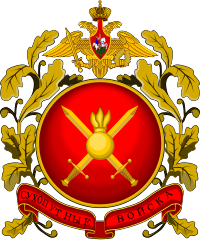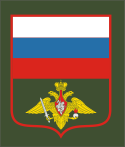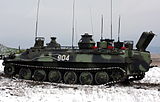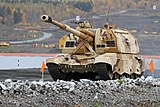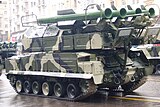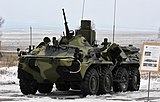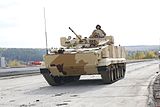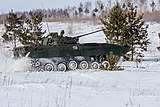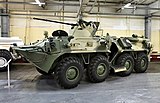Russian Ground Forces
The Russian Ground Forces (Russian: Сухопутные войска [СВ], romanized: Sukhoputnyye voyska [SV]), also known as the Russian Army (Russian: Армия России, romanized: Armiya Rossii, lit. 'Army of Russia'), are the land forces of the Russian Armed Forces.
The main responsibilities of the Russian Ground Forces are the protection of Russia's borders, combat on land, and the defeat of enemy troops. The President of Russia is the Supreme Commander-in-Chief of the Armed Forces of the Russian Federation. The Main Command of the Ground Forces is based in Moscow.
History
[change | change source]As the Soviet Union dissolved, Soviet officials tried to keep the Soviet Armed Forces as a single military for the new Commonwealth of Independent States. The last Minister of Defence of the Soviet Union, Marshal Yevgeny Shaposhnikov, was made supreme commander of the CIS Armed Forces in December 1991.[6] Once it became clear that Ukraine (and possibly the other republics) was going to form their own armed forces, the new Russian government moved to form its own armed forces.[6]
Russian President Boris Yeltsin signed a decree creating the Russian Ministry of Defence on 7 May 1992. This created the Russian Ground Forces and the other branches of the military.
Post-Soviet reform plans
[change | change source]The Ministry of Defence newspaper Krasnaya Zvezda published a reform plan on 21 July 1992. The General Staff turned further towards conservatism. This caused a lot of problems. The reform plan wanted a change from an Army-Division-Regiment structure to a Corps-Brigade structure. They wanted the new structures to be better in a situation with no front line.[7]
Few of the reforms planned in the early 1990s actually happened. This was for three reasons: Firstly, there was not enough help or support from the government, with President Yeltsin mainly interested in making sure that the Armed Forces were controllable and loyal, rather than reformed.[8][9] Secondly, there was not enough funding. Finally, there was no consensus in the military about what reforms should happen.
Crime and corruption in the ground forces
[change | change source]The new Russian Ground Forces also got a growing crime problem from their Soviet predecessors. As draft resistance grew in the last years of the Soviet Union, the authorities put people with criminal records and who spoke little or no Russian in the army. Crime rates grew quickly.[10] Weapons disappeared or were stolen more as well.[10]
In March 2011, Military Prosecutor General Sergei Fridinsky reported that crimes had been rising in the Russian Ground Forces for the past 18 months, with 500 crimes reported in the period of January to March 2011 alone.[11]
In August 2012, Prosecutor General Fridinsky again said that there was a rise in crime. Murders rose by more than half, bribery cases doubled, and drug trafficking rose by 25% in the first six months of 2012 compared to the same period in 2011. The Union of the Committees of Soldiers' Mothers of Russia said the state of the Russian army was a "crime against humanity".[12]
In July 2013, the Prosecutor General's office showed that corruption in 2013 rose 450% compared to 2012. This corruption cost the Russian government 4.4 billion rubles (US$130 million).[13]
Chechen Wars
[change | change source]First Chechen War
[change | change source]With the dissolution of the Soviet Union, the Chechens declared independence in November 1991. They declared independence under the leadership of a former Air Forces officer, General Dzhokar Dudayev.[14] Chechen independence was seen as lowering Moscow's authority. Chechnya was seen as a haven for criminals. Soon a group within the Kremlin wanted war. A Security Council meeting was held 29 November 1994 on the issue. Yeltsin ordered the Chechens to disarm, or else Moscow would invade. Defense Minister Pavel Grachev told Yeltsin that he would "take Grozny with one airborne assault regiment in two hours."[15]
The operation started on 11 December 1994 and, by 31 December, Russian forces were entering Grozny, the Chechen capital. The 131st Motor Rifle Brigade was told to make a push for the centre of the city. However, it was almost fully destroyed in Chechen ambushes. After finally taking Grozny, Russian troops moved on to other Chechen strongholds. Chechen militants took hostages in the Budyonnovsk hospital hostage crisis in Stavropol Krai in June 1995. This caused hope for peace. However, the fighting continued. After this incident, the Chechen separatists were called insurgents or terrorists in Russia.
Dzhokar Dudayev was assassinated in a Russian airstrike on 21 April 1996. In that summer, a Chechen attack retook Grozny. Secretary of the Security Council Alexander Lebed began talks with the Chechen rebel leader Aslan Maskhadov in August 1996 and signed an agreement on 22/23 August. The agreement was that by the end of that month, the fighting would end.[16] The ceasefire was signed in the Dagestani town of Khasavyurt on 31 August 1996.
Second Chechen War
[change | change source]The Second Chechen War started in August 1999 after Chechen militias invaded Dagestan. After this was a series of four terrorist bombings across Russia. This caused Russian military action against the alleged Chechen culprits.
In the First Chechen War, the Russians bombarded an area with artillery and airstrikes before moving the land forces. Improvements were made in the Ground Forces between 1996 and 1999 and its performance during the Second Chechen War improved because of this.[17]
The war started to slow down, however. Small-scale conflict continued to happen. As of November 2007, fighting had spread across other parts of the Russian Caucasus.[18] The Second Chechen War officially ended on 16 April 2009.[19]
Russo-Ukrainian War
[change | change source]Russia started putting many troops on the Ukrainian border starting in late 2021.
On February 24, 2022, Russian troops began invading Ukraine.[20] During this invasion, Russia lost many tanks to Ukrainian anti-tank systems. As of 6 May, at least 12 generals have been killed in Ukraine.
Equipment
[change | change source]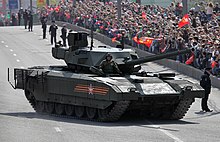
The Russian Ground Forces has lots of vehicles and equipment.[21] A lot of these are older Soviet designs.
New equipment, like the Armata Universal Combat Platform, Bumerang, and Kurganets-25, has been brought in since 2015. They have begun replacing old tanks and armored vehicles such as the BMPs, BTRs like the T-72, T-90, BMP-1/2/3, and BTR-80s.
Equipment summary
[change | change source]Figures listed as "Active" only include equipment that is in active service.
| Type | Active | Reserve |
|---|---|---|
| Main battle tanks | 2,800[22] | ≈16,500[23][24] |
| Infantry fighting vehicles | 5,160[22] | ≈19,500[22] |
| Armoured personnel carriers | 6,100[22] | ≈18,000+[22] |
| Towed artillery | 150[22] | ≈12,415[22] |
| Self-propelled artillery | 1,610[22] | ≈4,260[22] |
| Rocket artillery | 1,352[25] | |
| SAM systems | 2,531[26] |
- List of equipment of the Russian Ground Forces
-
 2K12 Kub (400 units)
2K12 Kub (400 units) -
 ZSU-23-4 Shilka (350 units)
ZSU-23-4 Shilka (350 units) -
 Tornado (multiple rocket launcher) (250 units)
Tornado (multiple rocket launcher) (250 units) -
 BM-21 Grad (100 units)
BM-21 Grad (100 units) -
 BM-30 Smerch (100 units)
BM-30 Smerch (100 units) -
-
-
 T-72 (7,000 units)
T-72 (7,000 units) -
 S-300 Antey-300/S-300V4 (2,000 units)
S-300 Antey-300/S-300V4 (2,000 units) -
 9P149 Shturm-S/SM (900 units)
9P149 Shturm-S/SM (900 units) -
 T-90 (370 units)
T-90 (370 units) -
 BMP-3 (620 units)
BMP-3 (620 units) -
 BMP-2 (4,500 units)
BMP-2 (4,500 units) -
 TOS-1 (30 units)
TOS-1 (30 units) -
 2S7M Malka (60 units)
2S7M Malka (60 units) -
 BTR-90 (6,000 units)
BTR-90 (6,000 units) -
 MT-LB (4,000 units)
MT-LB (4,000 units) -
 BPM-97 (5,500 units)
BPM-97 (5,500 units) -
 Iskander-M Missile (302 units)
Iskander-M Missile (302 units) -
 BTR-82A (Over 1,000 units)
BTR-82A (Over 1,000 units) -
 T-80 (450 units)
T-80 (450 units)
Ranks and insignia
[change | change source]The Russian Army kept most of the ranks of the Soviet Army, with some small changes.
References
[change | change source]- ↑ "Главная СВ". 470sv.mil.ru. Archived from the original on 2020-10-25. Retrieved 2020-11-30.
- ↑ Central Intelligence Agency (12 October 2022). "Russia". World Fact Book.
- ↑ Main Cathedral of Russian Armed Forces. Archived 2019-02-02 at the Wayback Machine Retrieved 2019-02-02.
- ↑ "Ukraine: With Minsk stalled, Russian sanctions must continue". 3 March 2016. Archived from the original on 2016-03-26. Retrieved 2016-03-29.
- ↑ Главнокомандующий Сухопутными войсками Олег Салюков. Биография (in Russian). ITAR TASS. Archived from the original on 2014-05-06. Retrieved 6 May 2014.
- ↑ 6.0 6.1 International Institute for Strategic Studies (1992). The Military Balance 1992–3. London: Brassey's. p. 89.
- ↑ Dick, Charles (November 1993). "Russian Views on Future War—Part 3". Jane's Intelligence Review. IHS Jane's: 488. ISSN 1350-6226.
- ↑ Baev, Pavel (1996). The Russian Army in a Time of Troubles. International Peace Research Institute. Oslo: Sage Publications. p. 67. ISBN 978-0-7619-5187-2.
- ↑ Arbatov, Alexei (Spring 1998). "Military Reform in Russia: Dilemmas, obstacles, and prospects". International Security. 22 (4): 112. doi:10.2307/2539241. ISSN 0162-2889. JSTOR 2539241.
- ↑ 10.0 10.1 Odom (1998), p. 302
- ↑ "No solution to hideous army hazing in Russia", Pravda (25 March 2011)
- ↑ "Crime reportedly flourishes in Russian army", Deutsche Welle (18 August 2012)
- ↑ "Corruption Up 450% in a Year in Russian Military – Prosecutors ", RIA Novosti (11 July 2013)
- ↑ Finch, Raymond C., III, MAJ. Why the Russian Military Failed in Chechnya (Report). Fort Leavenworth, Kansas: Foreign Military Studies Office. Archived from the original on 2006-10-15.
{{cite report}}: CS1 maint: multiple names: authors list (link) - ↑ Herspring, Dale (July 2006). "Undermining Combat Readiness in the Russian Military". Armed Forces & Society. 32 (4): 512–531. doi:10.1177/0095327X06288030. ISSN 0095-327X. S2CID 110963490. [citing Blandy, C. W. (January 2000). Chechnya: Two Federal Interventions: An interim comparison and assessment (Report). Conflict Studies Research Centre. p. 13. P29. Archived from the original on 2010-12-19. Retrieved 2010-09-09.]
- ↑ Scott, Harriet Fast; Scott, William F. (2002). Russian Military Directory. p. 328.
- ↑ Orr (2000), pp. 88–90
- ↑ "Chechnya and the North Caucasus". AlertNet. Thomson Reuters Foundation. 4 November 2007. Archived from the original on 2011-02-24. Retrieved 8 September 2010.
- ↑ "Russia 'ends Chechnya operation'". BBC News. BBC. 16 April 2009. Archived from the original on 2011-02-08. Retrieved 2011-03-01.
- ↑ "Photos: Russia launches 'full-scale invasion' in Ukraine".
- ↑ IISS 2006, p. 155
- ↑ 22.0 22.1 22.2 22.3 22.4 22.5 22.6 22.7 22.8 Military Balance 2020. p. 196.
- ↑ T-72 Archived 2013-10-25 at Archive.today, warfare.ru – Russian Military Analysis. Retrieved on 8 January 2014.
- ↑ T-80 Archived 2014-01-08 at the Wayback Machine, warfare.ru – Russian Military Analysis. Retrieved on 8 January 2014.
- ↑ Multiple Rocket Launchers database Archived 2013-10-24 at Archive.today, warfare.ru – Russian Military Analysis. Retrieved on 2 January 2013.
- ↑ SAM systems Archived 2013-12-27 at the Wayback Machine, warfare.ru – Russian Military Analysis. Retrieved on 2 January 2013.
Bibliography
[change | change source]- Arbatov, Alexei (1998). "Military Reform in Russia: Dilemmas, Obstacles, and Prospects". International Security. 22 (4). The MIT Press: 83–134. doi:10.2307/2539241. JSTOR 2539241.
- Austin, Greg & Muraviev, Alexey D. (2001). The Armed Forces of Russia in Asia. Tauris. ISBN 1-86064-485-6.
- Babakin, Alexander (August 20–26, 2004). "Approximate Composition and Structure of the Armed Forces After the Reforms". Nezavisimoye Voyennoye Obozreniye [Independent Military Review] (31).
- Baev, Pavel (1996). The Russian Army in a Time of Troubles. Oslo: International Peace Research Institute. ISBN 0-7619-5187-3.
- Baumgardner, Neil. "Russian Armed Forces Order of Battle". Archived from the original on 2009-10-19.
- Butowsky, Piotr (July 2007). "Russia Rising". Air Forces Monthly.
- Central Intelligence Agency (2006). "World Fact Book".
- Dick, Charles. (November 1993). "Russian Views on Future War, Part 3". Jane's Intelligence Review.
- "How are the mighty fallen". The Economist. 2005-06-30.
- Fes'kov, V.I.; Golikov, V.I. & K.A. Kalashnikov (2004). The Soviet Army In The Years Of The Cold War 1945–1991. Tomsk University Publishing House. ISBN 5-7511-1819-7.
- Finch, Raymond C. "Why the Russian Military Failed in Chechnya". Fort Leavenworth, KS: Foreign Military Studies Office. Archived from the original on 2006-10-15.
- Galeotti, Mark (February 1997). "Moscow's armed forces: a city's balance of power". Jane's Intelligence Review.
- Giles, Keir (May 2007). "Military Service in Russia: No New Model Army" (PDF). CSRC. Archived from the original (PDF) on 2021-12-31. Retrieved 2022-12-28.
- Golts, Alexander (2004). "Military Reform in Russia and the Global War Against Terrorism". Journal of Slavic Military Studies. 17: 29–41. doi:10.1080/13518040490440647. S2CID 154254640.
- Herspring, Dale (July 2006). "Undermining Combat Readiness in the Russian Military". Armed Forces & Society. 32 (4). doi:10.1177/0095327X06288030. S2CID 110963490.
- "The Military Balance". International Institute for Strategic Studies. Archived from the original on 2013-01-19. Retrieved 2011-03-01.
- Lenskii, A.G. & Tsybin, M.M. (2001). The Soviet Ground Forces in the Last Years of the USSR. St Petersburg: B&K Publishers.
- Lukin, Mikhail & Stukalin, Aleksander (14 May 2005). "Vsya Rossiyskaya Armiya". Kommersant-Vlast. Moscow.
- James H. Brusstar & Ellen Jones (January 1995). "McNair Paper 34, The Russian Military's Role in Politics". Archived from the original on 2008-01-14.
- Odom, William E. (1998). The Collapse of the Soviet Military. Yale University Press. ISBN 0-300-07469-7.
- Orr, Michael (June 1998). The Russian Armed Forces as a factor in Regional Stability (Report). CSRC.
- Orr, Michael (2000). Better or Just Not So Bad? An Evaluation of Russian Combat Performance in the Second Chechen War (Report). CSRC.
- Orr, Michael (2003). The Russian Ground Forces and Reform 1992–2002 (Report).
- Parchomenko, Walter (1999). "The State of Russia's Armed Forces and Military Reform". The US Army War College Quarterly: Parameters. 29 (4). doi:10.55540/0031-1723.1949. S2CID 234001418.
- Quartly, Alan (8 March 2003). "Miss Shooting Range crowned". BBC News.
- Robinson, Colin (2005). "The Russian Ground Forces Today: A Structural Status Examination". Journal of Slavic Military Studies. 18 (2): 189–206. doi:10.1080/13518040590944421. S2CID 145691472.
- Schofield, Carey (1991). Inside the Soviet Army. London: Headline. ISBN 0-7472-0418-7.
- Scott, Harriet Fast & Scott, William F. Russian Military Directories 2002 & 2004
- Suvorov, Viktor (1982). Inside the Soviet Army. London: Macmillan. ISBN 0-586-05978-4.
- Turbiville, Graham H. (1995). Mafia in Uniform: The Criminalisation of the Russian Armed Forces. Fort Leavenworth: U.S. Army Foreign Military Studies Office.

